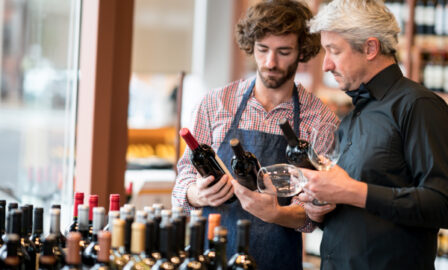Going Digital in Wine and Spirits Distribution
The concept of digital in wine and spirits distribution may seem out of reach. Especially so since the distribution system has remained relatively unchanged since the inception of the 3-tier system at the repeal of Prohibition in 1933.
However, changing consumer tastes and rapid technology developments have begun to disrupt the industry from the bottom-up. Tightening state regulations and increasing industry consolidation among larger players have sustained the U.S. wholesale position for nearly a century. Today’s consumers however, demand more niche products from smaller manufacturers at greater convenience. These two divergent factors have created an apparent disconnect in the marketplace. Across industries, the power is with the consumer – wine and spirits are no longer the exception to this rule.
Industry Disconnect for Digital in Wine and Spirits
Consolidation is a well-documented challenge for the wine and spirits industry. In just 10 years, the top 4 companies in the global beer market represented more than 50% of the global market (vs. 32% for the top 5 players in 2003). Meanwhile, the number of specialized wine and spirits producers in the U.S. has grown tremendously led by the dramatic rise of craft breweries and distilleries.
The disconnect lies between fragmenting consumer tastes concurrent with consolidated production and distribution networks. Consolidation between a few producers distributing through a few large wholesalers tends to constrain consumer selection and limit access to the newly desired niche, craft products.
Despite having a large portion of the market share, large distributors need to get focused on digital because as niche products become more prevalent these companies need to be more agile. Some large distributors are taking action through acquisitions and strategic partnership alignments, but there is still a long road ahead. Digital disruption is meeting changing consumer demand with innovative technologies that ease market entry for small manufacturers.
As a wholesaler, are you adapting to the age of digital disruption?
Here are two ways digital in wine and spirits industry are changing:
1. Transparency is breaking down barriers to entry
Access to reliable distributor data and product availability are nearly impossible to find through generic web searches. This forces small businesses to track down sales reps, flip through pricing catalogues, and reach out to other contacts within the industry for accurate information. Once a large barrier to entry, technology companies are now providing greater access to this data for smaller, up-and-coming manufacturers, retailers, and distributors alike.
New York City-based startup, SevenFifty raised over $8.5M in Series A funding to modernize the way retailers (e.g. restaurants, stores, and bars) buy wine and spirits. The online platform empowers trade professionals to easily search for products, wholesale pricing, inventory levels, and be connected directly with distributor sales reps from local and national level vendors. The company currently works with more than 700 distributors and 30,000 retailers across 30 states.
SevenFifty has made my life infinitely more efficient and it has made purchasing wine for the restaurants infinitely more agreeable. Thank you SevenFifty for freeing up hours of my life so that I can focus on running a beverage program instead of sorting through piles of outdated price books.
-Jordan Salcito (Director of Beverage Operations at Momofuku)
- Disruption Takeaway – Digital disrupters are leveraging the internet to provide a more efficient, transparent market for buyers. Smaller manufacturers, retailers, and distributors are gaining direct access to insightful wholesale data, previously safeguarded by industry consolidation. This type of disruption is breaking down a huge barrier to entry for most up-and-coming businesses.
- Wholesaler Takeaway – Wholesale should consider adjusting to evolving consumer tastes and not risk the potential missed opportunities associated with craft brews and distilleries – i.e. what consumers want.
2. The increase in accessibility for all
Liberation Distribution (LibDib), a tech startup recently founded San Jose, California enables the distribution of wine and spirit beverages through a three-tier compliant web platform. LibDib Founder and CEO, Cheryl Durzy aims to empower smaller, mid-size producers and distributors to be able to compete within the heavily consolidated industry. By leveraging this online wholesale pure-play, retailers, restaurants, and bars in California and New York are now legally able to purchase niche wines, craft spirits, and microbrews from producers and distributors of all sizes.
The wine and spirits distribution market hasn’t changed for more than eighty years and is ripe for innovation.
-LibDib CTO, Richard Brashears.
- Disruption Takeaway – Companies like LibDib are meeting the consumer need in a new way. Wholesale might be missing out on an opportunity for rising consumer demand if 100 percent of their efforts continue to be focused solely on large manufacturers and retailers.
- Wholesaler Takeaway – Acquisition and diverse portfolio is potentially an inadequate response to digital disruption. There is an incredible opportunity for wholesalers to strike a balance between supplier partners and evolving consumer tastes. Consider adopting or embracing digital as a means to strike that balance, or risk being disrupted by smaller market entrants leveraging internet technologies.
Conclusion
Prepare your business for the digital age of the wine and spirits distribution industry. Through digital, consumers will soon get the products they desire at their utmost convenience. Wholesalers continuing to focus on building strong relationships with large manufacturers should recognize the industry disconnect in consumer demand for new, fun products created by small/mid-size manufacturers. Striking a balance between acceptance of digital and maintaining wholesale partnerships will be the key to future success. Wholesale companies must begin thinking about how they should do business differently to capitalize on this incredible opportunity in the face of digital disruption.
To learn more about Clarkston’s wholesale distribution services or about digital in wine and spirits distribution, please contact us.
Subscribe to Clarkston's Insights
Coauthor and contributions by Christian Olsen



